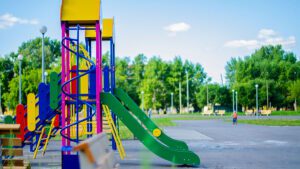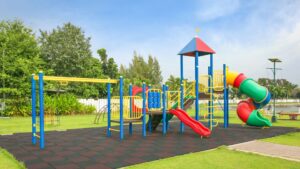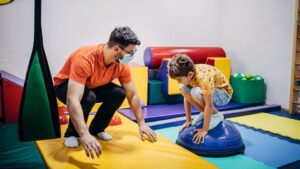Indoor-Spielplätze sind zu wichtigen Zentren der Gemeinschaft geworden und bieten sichere, wetterfeste Umgebungen, in denen Kinder aller Altersgruppen spielen, lernen und Kontakte knüpfen können. Gut konzipierte Indoor-Spielplätze nutzen eine Vielzahl von Strukturen, um die Fantasie anzuregen, motorische Fähigkeiten zu entwickeln und die Zusammenarbeit zu fördern. In diesem Artikel werden wir fünf Haupttypen von Indoor-Spielplatzstrukturen, ihre Vorteile und Gestaltungstipps vorstellen, die Ihnen helfen, einen dynamischen und ansprechenden Spielraum zu schaffen.

1. Kletternde Strukturen
Was sie sind
Kletterstrukturen sind modulare Spielsysteme, die aus Leitern, Seilnetzen, Lastenaufstiegen und Tunneln bestehen. Sie können von einfachen einstöckigen Gerüsten bis hin zu mehrstöckigen Spielburgen mit Überkopfbrücken und Aussichtsplattformen reichen.
Vorteile
- Grobmotorische Entwicklung: Klettern trainiert die Kraft des Oberkörpers und der Körpermitte, während die Kinder ziehen, schieben und balancieren.
- Problemlösung: Die Kinder müssen Routen planen und Hindernisse überwinden, was ihre kognitive Flexibilität fördert.
- Vertrauen und Risikobewertung: Die erfolgreiche Bewältigung einer Klettertour stärkt das Selbstbewusstsein und lehrt die sichere Übernahme von Risiken.
Design-Tipps
- Bieten Sie verschiedene Schwierigkeitsgrade: leichte Rampen für Kleinkinder und steilere Netze für ältere Kinder.
- Sorgen Sie für sichere Fallzonen mit stoßdämpfenden Belägen wie Gummifliesen oder Holzfaserwerkstoffen.
- Integrieren Sie bunte Tafeln oder thematische Elemente (Dschungelranken, Piratentakel), um die Fantasie anzuregen.

2. Softplay-Strukturen
Was sie sind
Soft-Play-Zonen bestehen aus gepolsterten Schaumstoffteilen - Blöcken, Tunneln, Rutschen und Bällebädern -, die mit haltbaren Vinylbezügen überzogen sind. Diese Bereiche sind ideal für Kleinkinder und Vorschulkinder und bieten vor allem Sicherheit und sensorische Erkundung.
Vorteile
- Sichere Erkundung: Die gepolsterten Oberflächen minimieren das Verletzungsrisiko für Anfänger, die noch an ihren motorischen Fähigkeiten feilen.
- Taktiles Engagement: Weiche Texturen laden zum Krabbeln, Rollen und Klettern mit geringer Belastung ein.
- Soziales Spiel: Geschlossene Anlagen fördern das kooperative Spiel und Gruppenspiele.
Design-Tipps
- Schaffen Sie nach Altersgruppen getrennte Bereiche mit niedrigen Wänden, um jüngere Kinder vom aktiveren Spiel zu trennen.
- Bauen Sie transparente Fenster in Schaumstoffwände ein, damit das Pflegepersonal alle Aktivitäten überwachen kann.
- Fügen Sie themenbezogene weiche Hindernisse wie Schaumstoffpilze" oder Felsbrocken" hinzu, um den Raum zu beleben.
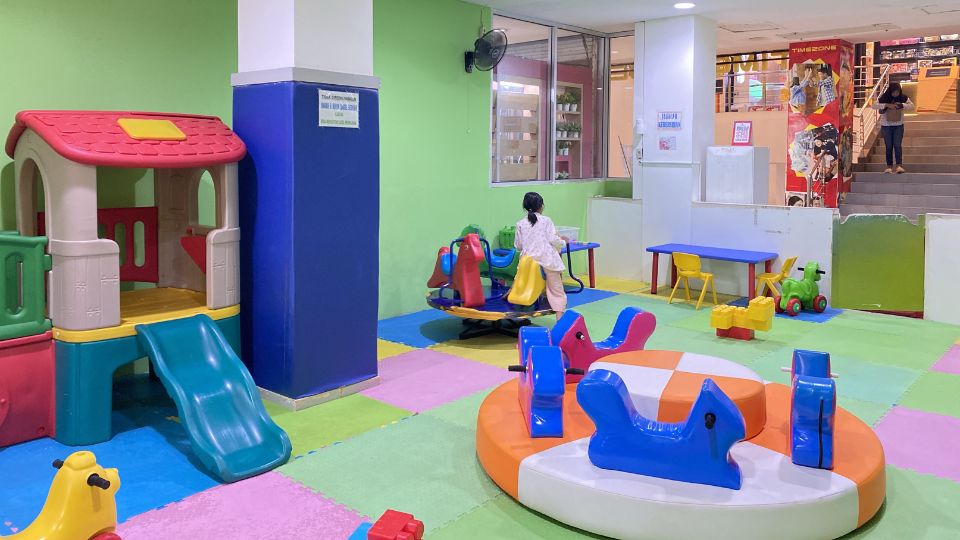
3. Sensorische Strukturen
Was sie sind
Sensorische Strukturen sprechen die fünf Sinne an und unterstützen Kinder mit sensorischem Förderbedarf. Typische Merkmale sind taktile Tafeln, Spiegelwände, Lichttunnel und musikalische Spielstationen.
Vorteile
- Sensorische Integration: Multisensorischer Input hilft Kindern, ihre Reaktionen auf Berührung, Klang und Licht zu regulieren.
- Beruhigungszonen: Ruhige Sinnesecken mit sanftem Licht und zarten Texturen bieten Rückzugsmöglichkeiten für überreizte Kinder.
- Inklusives Spiel: Geeignet für Kinder mit Autismus-Spektrum-Störung (ASD), ADHS und anderen sensorischen Problemen.
Design-Tipps
- Sorgen Sie für ein Gleichgewicht zwischen anregungsreichen Bereichen (Trommeltafeln, Sprudelröhren) und anregungsarmen Rückzugsmöglichkeiten (mit Stoff bespannte Ecken).
- Verwenden Sie die einstellbaren Beleuchtungs- und Lautstärkeregler, um die Sinneseindrücke anzupassen.
- Achten Sie darauf, dass alle Materialien ungiftig und leicht zu reinigen sind.
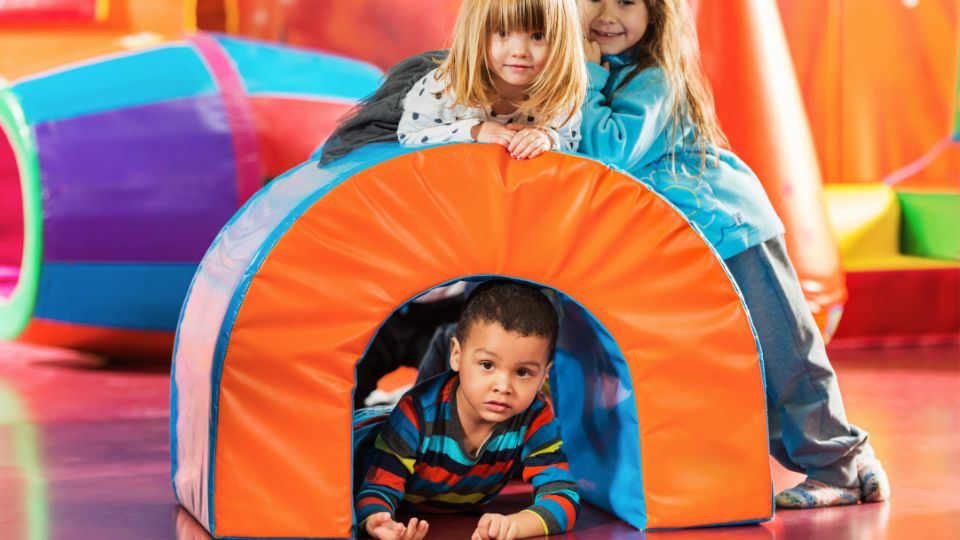
4. Rollenspiel und thematische Strukturen
Was sie sind
Die Rollenspielbereiche sind realen Umgebungen nachempfunden - Mini-Küchen, Lebensmittelläden, Feuerwachen oder Piratenschiffe -, komplett mit Requisiten, Kostümen und verkleinerten Möbeln.
Vorteile
- Imaginative Entwicklung: Die Kinder üben Sprache, soziale Rollen und erzählerische Fähigkeiten.
- Soziale Interaktion: Kooperative Szenarien fördern das Verhandeln, den Austausch und das Einfühlungsvermögen.
- Frühe Alphabetisierung und Mathematik: Beim Vorspielen von Einkäufen oder Restaurantbesuchen wird das Zählen, Lesen von Speisekarten und Befolgen von Rezepten integriert.
Design-Tipps
- Wechseln Sie die Themen oder Requisiten saisonal, um das Spielerlebnis frisch zu halten.
- Stellen Sie Materialien mit offenem Ende zur Verfügung (eine Kommode mit Kostümhüten, leere "Speisekarten"), um die Kreativität zu fördern.
- Positionieren Sie die Rollenspielbereiche in der Nähe der Sitzgelegenheiten für Erzieher oder Betreuer, um das Erzählen von Geschichten anzuleiten.

5. Interaktive Spiel-Strukturen
Was sie sind
Interaktive Spielinstallationen verbinden physisches Spiel mit digitalen oder mechanischen Herausforderungen. Beispiele sind berührungsempfindliche Wandtafeln, bewegungsaktivierte Bodenspiele und einfache kinetische Puzzles.
Vorteile
- Kognitives Engagement: Problemlösungsaufgaben stärken das Gedächtnis, die Reihenfolgebildung und die logischen Fähigkeiten.
- Aktives Lernen: Körperliche Bewegung (Springen, um Ziele zu treffen, Rennen durch Matten) steigert die Fitness beim Lernen.
- Technologie-Integration: Bereitet die Kinder mit altersgerechten Schnittstellen auf die digitale Kompetenz vor.
Design-Tipps
- Entscheiden Sie sich für langlebige, vom Benutzer zu wartende Hardware, um Ausfallzeiten zu minimieren.
- Wählen Sie Spiele mit einstellbarem Schwierigkeitsgrad für verschiedene Altersgruppen.
- Stellen Sie sicher, dass die elektrischen und digitalen Komponenten alle Sicherheits- und Wasserdichtigkeitsstandards erfüllen.

6. Kombinationen aus Rutsche und Tunnel
Was sie sind
Rutschen und Tunnel sind die Klassiker unter den Spielplatzgeräten. Die Indoor-Versionen reichen von kurzen, weichen Rutschen für Kleinkinder bis hin zu langen, gewundenen Röhrenrutschen für ältere Kinder.
Vorteile
- Vestibuläre Stimulation: Rutschen und Krabbeln durch Tunnel verbessern das Gleichgewicht und das räumliche Bewusstsein.
- Grobmotorische Fertigkeiten: Das Erklimmen von Leitern und das Überwinden von Zugängen fördert die Koordination.
- Unendlicher Spaß: Die allseits beliebten Rutschen beschäftigen die Kinder stundenlang.
Design-Tipps
- Installieren Sie die Anlage in unterschiedlichen Höhen, mit sanften Steigungen für die Jüngeren und steileren Gefällen für den Nervenkitzel.
- Verwenden Sie durchsichtige Tunnelwände, damit Erwachsene das Innere sehen können.
- Integrieren Sie themenbezogene Rutscheneinstiege (Drachenmaul, Raketenstart).
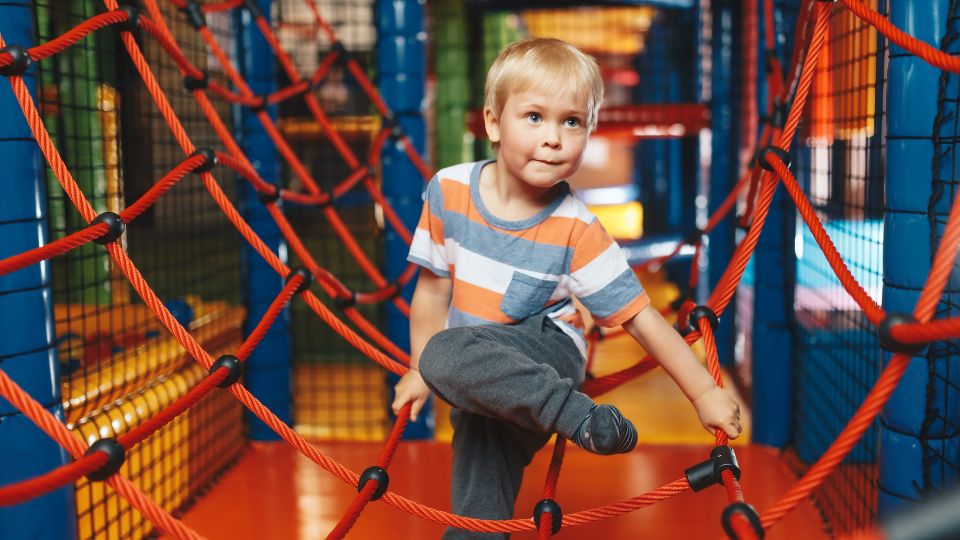
7. Trampolin & Soft-Jump Bereiche
Was sie sind
In Indoor-Trampolinbereichen oder Schaumstoff-Sprungzonen können Kinder sicher auf Minitrampolinen oder in gepolsterten Gruben hüpfen.
Vorteile
- Kardiovaskuläre Fitness: Springen erhöht die Herzfrequenz auf sanfte Art und Weise.
- Propriozeption und Koordination: Aktivitäten zur Körperwahrnehmung verfeinern die motorische Planung.
- Energiefreigabe: Ideal für energiegeladene Kinder, um die Bewegung zu kanalisieren.
Design-Tipps
- Umgeben Sie Trampoline mit Sicherheitsnetzen oder gepolsterten Wänden.
- Positionieren Sie Schaumstoffgruben unter Kletter- oder Luftelementen.
- Geben Sie Richtlinien für Gewicht und Größe an, um eine sichere Benutzung zu gewährleisten.

8. Musikalische & Klang-Zonen
Was sie sind
Zu den musikalischen Strukturen gehören Xylophontafeln, Trommelwände, Glockenspielstationen und interaktive Soundboards.
Vorteile
- Auditive Entwicklung: Rhythmisches Spielen verbessert das Hörvermögen und die Takterkennung.
- Kreativer Ausdruck: Kinder erforschen Ursache und Wirkung, indem sie Geräusche erzeugen.
- Inklusives Spiel: Nicht wettbewerbsorientiert und für verschiedene Altersgruppen und Fähigkeiten geeignet.
Design-Tipps
- Verwenden Sie wetterfeste, haltbare Metalle oder Kunststoffe für Instrumente, die für den Außenbereich bestimmt sind.
- Montieren Sie Paneele in verschiedenen Höhen für Kleinkinder und Teenager.
- Kombinieren Sie mit Sitzgelegenheiten oder Ruhezonen, um den Lärmpegel auszugleichen.
9. Balancierbalken & Hindernisparcours
Was sie sind
Kleine Balken, Trittsteine, Wackelbretter und niedrige Hürden, die zu Mini-Hindernisparcours angeordnet sind.
Vorteile
- Kernkraft und Beweglichkeit: Schmale Oberflächen fordern Gleichgewicht und Konzentration.
- Sequenzielle Planung: Die Kinder lernen, Routen zu planen und sich anzupassen, während sie sich bewegen.
- Gruppenspiel: Wettrennen oder "Follow-the-Leader"-Spiele fördern die Übernahme von Aufgaben.
Design-Tipps
- Mehrere Schwierigkeitsgrade: breite Balken für Anfänger, schmalere für Fortgeschrittene.
- Verwenden Sie gut sichtbare Farben und rutschfeste Oberflächen.
- Integrieren Sie Kletter- oder Rutschelemente für ein Spiel im Kreislauf.
10. Sinnespfade und taktile Pfade
Was sie sind
Bodennahe Wege, die verschiedene Texturen und Materialien kombinieren - Gummimatten, Schaumstoffhügel, Teppichquadrate, taktile Fliesen.
Vorteile
- Sensorische Erkundung: Barfußlaufen oder Krabbeln erhöht den taktilen Input.
- Feinmotorisches Engagement: Spiele, die den Linien folgen, oder das Nachzeichnen von Kanten fördern die Hand-Augen-Koordination.
- Achtsame Bewegung: Langsame, bewusste Navigation fördert das Körperbewusstsein und die ruhige Konzentration.
Design-Tipps
- Sorgen Sie für robuste, antimikrobielle Bodenbeläge.
- Bieten Sie Farb- oder Formaufforderungen an, um den Weg spielerisch zu gestalten (z. B. "hüpfe auf jeden roten Kreis").
- In der Nähe von Ruhe- oder Leseecken für eine sensorische Pause.
Schlussfolgerung
Ein abgerundeter Indoor-Spielplatz vereint mehrere Strukturtypen.Klettergerüste, Soft-Play-Zonen, sensorische Tafeln, Rollenspielbereicheund interaktive Spiele-, um eine reichhaltige Umgebung zu schaffen, die das körperliche, kognitive und soziale Wachstum fördert. Durch die durchdachte Auswahl und Anordnung dieser Elemente können Sie einen Spielraum gestalten, der jedes Kind fesselt, vom energiegeladenen Kletterer bis zum phantasievollen Geschichtenerzähler und Sinnessucher.
Ob Sie nun ein Gemeindezentrum, eine Schule oder eine Kindertagesstätte ausstatten, denken Sie daran:
- Balance zwischen Herausforderung und Sicherheit: Bieten Sie Optionen für verschiedene Altersgruppen und Fähigkeiten an.
- Langlebigkeit und Hygiene haben Vorrang: Wählen Sie Materialien, die einer starken Beanspruchung und häufigen Reinigung standhalten.
- Förderung der Eingliederung: Sinnes- und Rollenspielbereiche für Kinder mit unterschiedlichen Bedürfnissen einrichten.
Mit diesen Richtlinien und der richtigen Mischung aus Indoor-Spielplatzstrukturen bieten Sie eine dynamische, unterstützende Spielumgebung, in der jedes Kind spielen, lernen und wachsen-Regen oder Sonnenschein.

